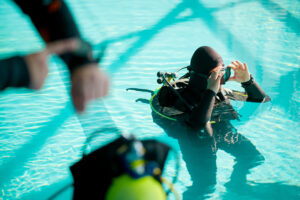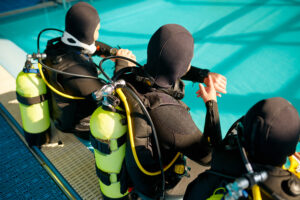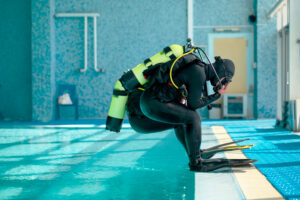Can you get Hyperthermia when Scuba Diving?
Hyperthermia is a condition characterized by an elevated body temperature above the normal range, can pose a significant risk to scuba divers if not managed effectively. In the context of scuba diving, hyperthermia can result from overheating in a wetsuit, leading to a myriad of potential health issues. As divers descend into the depths of the ocean, it is crucial to understand the causes, symptoms, prevention, and treatment of hyperthermia to ensure a safe and enjoyable diving experience.
Causes of Hyperthermia in Scuba Diving
Inappropriate Wetsuit Choice
The primary cause of hyperthermia while diving is wearing an improperly fitted or excessively insulated wetsuit. Wetsuits are designed to trap a thin layer of water between the suit and the diver’s body, which is then warmed by the body’s heat. This creates an insulating barrier against the surrounding cold water. However, if a wetsuit is too thick or tight, it can trap excessive heat, causing the diver’s body temperature to rise to dangerous levels.
High Ambient Temperature
Diving in tropical or warm waters can increase the risk of hyperthermia, particularly if the diver is wearing a wetsuit designed for colder temperatures. In these environments, the water may not be cold enough to dissipate the excess heat generated by the body, leading to overheating.
Overexertion
Strenuous physical activity during a dive can also contribute to the development of hyperthermia. As divers exercise their muscles, they generate more heat, which can raise their core body temperature. If the body is unable to effectively dissipate this heat, it may result in hyperthermia.
Symptoms of Hyperthermia
Divers experiencing hyperthermia may exhibit a range of symptoms, including:
Increased heart rate and respiratory rate
As the body attempts to cool itself, it will increase blood flow to the skin’s surface, resulting in an elevated heart rate. Additionally, the body will try to lose heat through rapid, shallow breathing.
Excessive sweating
Sweating is a natural response to overheating, but in the case of hyperthermia, it may not be enough to cool the body down effectively.
Flushed skin
The skin may appear red and feel warm to the touch due to increased blood flow near the surface of the skin.
Dizziness, nausea, and vomiting
As body temperature continues to rise, divers may experience feelings of dizziness, nausea, and even vomiting.
Confusion and disorientation
If left untreated, hyperthermia can lead to cognitive impairment, making it difficult for divers to make rational decisions or effectively communicate with their dive buddies.
Loss of consciousness
In severe cases, hyperthermia can lead to a loss of consciousness, which can be particularly dangerous while diving, as it may result in drowning.
Prevention of Hyperthermia in Scuba Diving
Choose the appropriate wetsuit
Select a wetsuit that is suitable for the water temperature and provides the correct level of insulation. Be mindful of the wetsuit’s thickness and fit, and consider using a thinner or shorty wetsuit when diving in warmer waters.
Stay hydrated
Proper hydration is essential in preventing hyperthermia. Drink plenty of water before and after diving to help your body maintain a healthy temperature balance.
Monitor exertion levels
Be mindful of your physical activity during a dive and take regular breaks to allow your body to cool down if necessary.
Acclimatize to the water temperature
Spend some time in the water before diving to give your body time to adjust to the water temperature. This can help minimize the risk of overheating during the dive.
Dive with a buddy: Having a dive partner can provide an extra layer of safety, as they can help monitor your condition and provide assistance if needed.
Pay attention to environmental conditions
Be aware of the water temperature and surrounding conditions when planning your dive. Adjust your gear and dive plan accordingly to minimize the risk of hyperthermia.
Treatment of Hyperthermia in Scuba Diving
Recognize the symptoms
The first step in treating hyperthermia is to recognize the signs and symptoms. If you or your dive buddy are experiencing any of the aforementioned symptoms, it is essential to take immediate action.
End the dive
If hyperthermia is suspected, abort the dive and begin a controlled ascent to the surface, following proper decompression procedures if necessary.
Remove the wetsuit
Once at the surface or back on the dive boat, remove the wetsuit to allow the body to cool down more effectively.
Hydrate
Drink plenty of cool water or a sports drink to help replenish fluids lost through sweating and to aid in the body’s cooling process.
Seek shade and rest
Find a cool, shaded area to rest and recover. Avoid direct sunlight and excessive physical activity.
Monitor symptoms
Keep a close eye on the affected diver’s symptoms, as hyperthermia can progress rapidly. If symptoms do not improve or worsen, seek immediate medical attention.
Medical attention
In severe cases, or if symptoms persist despite initial treatment efforts, consult a healthcare professional. Prolonged hyperthermia can lead to heat stroke, which can be life-threatening and requires immediate medical intervention.
Hyperthermia in scuba diving is a potentially dangerous condition that can result from overheating in a wetsuit. By understanding the causes, symptoms, prevention, and treatment of hyperthermia, divers can minimize the risk of this condition and ensure a safer diving experience. Always dive with a buddy, choose appropriate gear, and monitor your physical condition throughout the dive to maintain optimal safety.

















